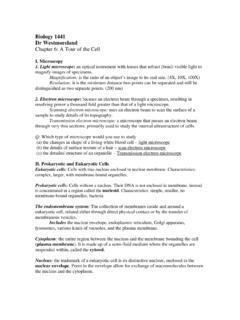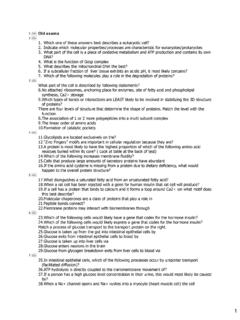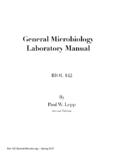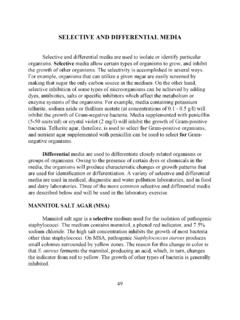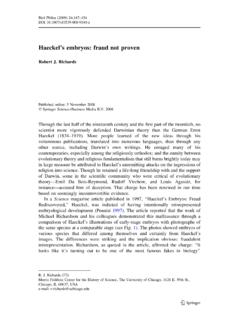Transcription of BIOL 2458 CHAPTER 19 – Part 2 SI RED BLOOD CELL ...
1 BIOL 2458 CHAPTER 19 Part 2 SI 1 RED BLOOD CELL abnormalities 1. _____ is due to severe bleeding. 2. _____ occurs when chemicals and radiation damage myeloid tissue and RBC are not produced. 3. _____ occurs when there is a lack of iron in the body. 4. _____ occurs when a lack of intrinsic factor leads to decreased absorption of vitamin B12. 5. _____ occurs when there is a problem producing the 4 globin chains. 6. _____ occurs when there is a change in the sequence of amino acids in hemoglobin. WBC 7. Neutrophils, eosinophils and basophils are _____ (granular or agranular) leukocytes produced by _____ tissue. (lymphoid or myeloid) 8. Which are microphages? _____ 9. Which release histamine and heparin? _____ What is the function of histamine? _____ What is the function of heparin?
2 _____ 10. Monocytes are _____ (granular or agranular) leukocytes produced by _____ tissue. (lymphoid or myeloid) They are also called _____ because they are large cells that can engulf organisms. They are also able to squeeze through tissues. This is called. _____ _____ macrophages are found in specific tissues, such as skin, liver and bone. 11. Lymphocytes are _____ (granular or agranular) leukocytes that are produced by _____ tissue. (lymphoid or myeloid) STEM cells (multipotent, omnipotent, pluripotent) 12. Embryonic stem cells , that can differentiate into all cell types, are _____ stem cells . Embryonic stem cells produce hemocytoblasts that are _____ stem cells . Hemocytoblasts produce myeloid and lymphoid stem cells that are _____ stem cells that produce WBC, RBC and platelets.
3 13. List the 3 cells derived from lymphoid stem cells . _____ List the 6 cells derived from myeloid stem cells . _____ _____ BIOL 2458 CHAPTER 19 Part 2 SI 2 CHEMICALS THAT DIFFERENTIATE cells (EPO, G-CSF, M-CSF, GM-CSF, multi-CSF) 14. A myeloid stem cell exposed to _____ will form all progenitor cells . 15. A progenitor cell exposed to _____ will ultimately form RBC. 16. A progenitor cell exposed to _____ will produce granulocytes and monocytes. 17. A myeloblast exposed to _____ will produce granulocytes. 18. A monoblast exposed to _____ will produce monocytes. HEMOSTASIS 19. _____ is the first step. It decreases the diameter of the BLOOD vessel. 20. During the _____ stage, platelets stick together and release chemicals that begin the clotting process, and some that will ultimately stop the clotting process.
4 21. During the _____ phase, clotting factors are activated. 22. During _____, fibers draw the BLOOD clot together (syneresis). 23. During _____, fibrinolysis occurs and the BLOOD clot dissolves. 24. Name the chemicals released during the platelet phase. _____ _____ 25. What is the function of ADP? _____ 26. Name the three pathways that are active during the coagulation phase. _____ 27. Extrinsic means that chemicals for BLOOD clotting are found _____ Intrinsic means that chemicals for BLOOD clotting are found _____ 28. Which pathway (extrinsic or intrinsic) is used when tissues are damaged? _____ Which pathway (extrinsic or intrinsic) is used when BLOOD is damaged? _____ 29. Associate the clotting factor name with the extrinsic or instrinsic pathway.
5 Tissue thromboplastin_____ Plasma thromboplastin_____ Platelet thromboplastin_____ 30. _____ is a bleeding disorder due to a deficiency of certain clotting factors. 31. _____ is a coenzyme that gives rise to some clotting factors. 32. _____ is activated by both the extrinsic and intrinsic pathways, and begins the common pathway. 33. Factor X forms the enzyme prothrombinase that converts _____ into _____. 34. Thrombin converts _____, a soluble protein, into _____, insoluble fibrous strands that trap RBC. BIOL 2458 CHAPTER 19 Part 2 SI 3 35. The _____ pathway dissolves the BLOOD clot. 36. _____ and _____ begin this process by activating plasminogen. 37. Plasminogen produces _____, and enzyme that dissolves the fibrin strands of the BLOOD clot.
6 BLOOD CLOT TERMINOLOGY 38. A _____ is a BLOOD clot that is attached to the inner wall of a BLOOD vessel. A _____ is the formation of the BLOOD clot. 39. An _____ is a BLOOD clot that detaches and travels through BLOOD vessels. An _____ occurs when a traveling BLOOD clot blocks a BLOOD vessel, stopping circulation at that point. CARDIOVASCULAR PROBLEMS 40. In _____, fatty plaque deposits build up in the middle layer of the BLOOD vessel and project into the lumen (hollow area where BLOOD flows). 41. In _____, the walls of the arteries become hardened (thickened and tough) and are not able to expand easily. 42. A _____ or heart attack occurs as a result of a coronary thrombosis (formation of a BLOOD clot in a coronary artery in the heart). BIOL 2458 CHAPTER 19 Part 2 - answers SI 4 1. hemorrhagic anemia 2. aplastic anemia 3.
7 Iron deficiency anemia 4. pernicious anemia 5. thalassemia 6. sickle cell anemia 7. granular; myeloid 8. neutrophils and eosinophils 9. basophils; inflammation; no clotting of BLOOD at site of infection 10. agranular; myeloid; macrophages; diapedesis; fixed 11. agranular; lymphoid 12. omnipotent; pluripotent; multipotent 13. lymphoid derived B lymphocytes, T lymphocytes, natural killer (NK) myeloid derived RBC, WBC (neutrophils, basophils, eosinophils, monocytes), megakaryocytes (pieces of cytoplasm become platelets) 14. multi-CSF (CSF = colony stimulating factors) 15. EPO (erythropoietin) 16. GM-CSF 17. G-CSF 18. M-CSF 19. vascular spasm 20. platelet plug 21. coagulation 22. clot retraction 23. clot destruction 24. ADP, thromboxane A2, calcium, platelet factors 25.
8 Begins platelet aggregation and secretion 26. extrinsic pathway, intrinsic pathway, common pathway 27. extrinsic - outside BLOOD ; intrinsic - in BLOOD 28. tissue damage extrinsic; BLOOD damaged intrinsic 29. tissue extrinsic; plasma and platelet intrinsic 30. hemophilia 31. vitamin K 32. factor X 33. prothrombin; thrombin 34. fibrinogen; fibrin 35. fibrinolytic 36. thrombin; tissue plasminogen activator (TPA) 37. plasmin 38. thrombus; thrombosis (definition from an online dictionary) 39. embolus; embolism 40. atherosclerosis 41. arteriosclerosis (see pg 713) 42. myocardial infarction

